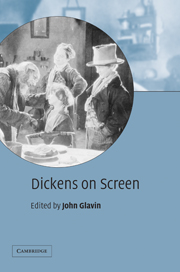Book contents
- Frontmatter
- Contents
- List of illustrations
- Notes on the contributors
- Acknowledgments
- Introduction
- Part I
- Part II
- Part III
- Part IV
- 11 Cinematic Dickens and uncinematic words
- 12 Dickens, Eisenstein, film
- 13 Orson Welles and Charles Dickens 1938–1941
- 14 David Copperfield (1935) and the US curriculum
- 15 Dickens, Selznick, and Southpark
- 16 Tiny Tim on screen: a disability studies perspective
- Part V
- Index
- References
14 - David Copperfield (1935) and the US curriculum
Published online by Cambridge University Press: 22 September 2009
- Frontmatter
- Contents
- List of illustrations
- Notes on the contributors
- Acknowledgments
- Introduction
- Part I
- Part II
- Part III
- Part IV
- 11 Cinematic Dickens and uncinematic words
- 12 Dickens, Eisenstein, film
- 13 Orson Welles and Charles Dickens 1938–1941
- 14 David Copperfield (1935) and the US curriculum
- 15 Dickens, Selznick, and Southpark
- 16 Tiny Tim on screen: a disability studies perspective
- Part V
- Index
- References
Summary
This chapter revisits the moment of David Copperfield's release (MGM 1935) to show how US educators attempted to incorporate this particular film, and films in general, into school curricula. Examination of the rhetoric surrounding David Copperfield also illustrates the ways in which educators approached, or indeed selectively avoided, issues surrounding cinema's cultural value and its relationship to literature. Popular film's entrance into the US school curriculum involved both motion-picture appreciation and the cultivation of conventional notions of taste and discrimination. Advocates of film education were consistent in suggesting that properly educated children, that is those who had obtained some experience studying cinema in their schools, could and would make the “right” choices in selecting their screen entertainment. English teacher Clifford Bragdon, of the Hawken School in Cleveland, Ohio, argued that “The school, public or private, can help children to overcome the habit of indiscriminate movie attendance by supplying information, arousing attitudes, and thus helping to establish habits which will enable children to find more sources of interest in the movies than they found before” (Bragdon 1937: 378). By one account, more than a hundred thousand students of at least a thousand different teachers were, in 1934, studying motion-picture appreciation, and at least seven state departments of education had officially sanctioned teaching film appreciation in their schools (Dale 1936: 113). Not surprisingly, pedagogical efforts surrounding the popular US film most often focused on adaptations of the generally agreed-upon canon of great literary works, like Copperfield.
- Type
- Chapter
- Information
- Dickens on Screen , pp. 155 - 170Publisher: Cambridge University PressPrint publication year: 2003
References
- 1
- Cited by

